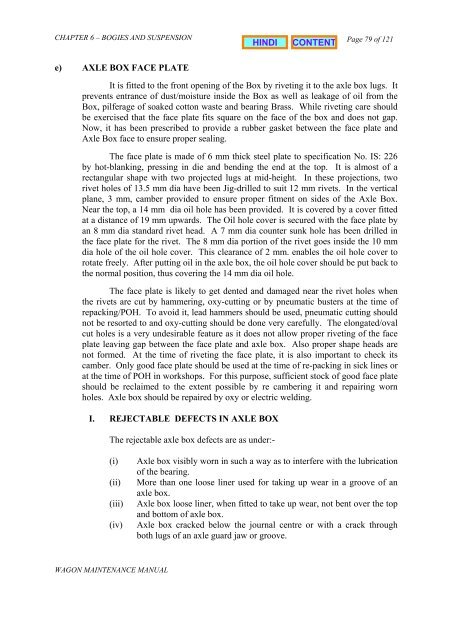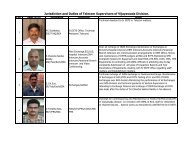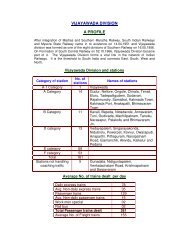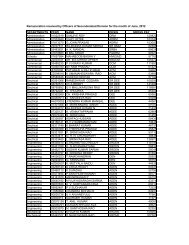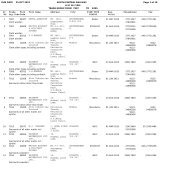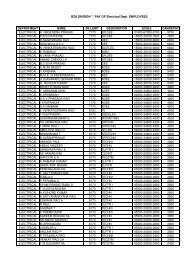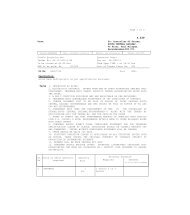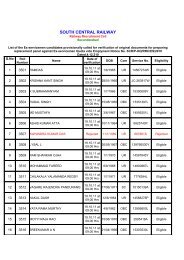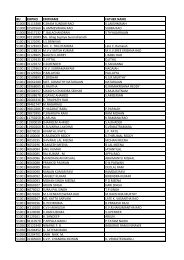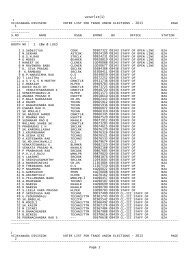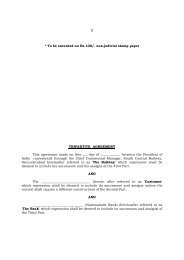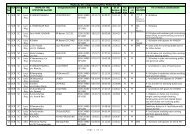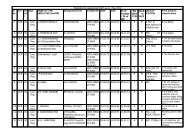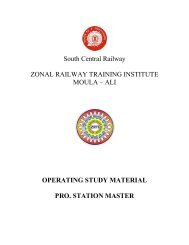BOGIES AND SUSPENSION - South Central Railway
BOGIES AND SUSPENSION - South Central Railway
BOGIES AND SUSPENSION - South Central Railway
Create successful ePaper yourself
Turn your PDF publications into a flip-book with our unique Google optimized e-Paper software.
CHAPTER 6 – <strong>BOGIES</strong> <strong>AND</strong> <strong>SUSPENSION</strong><br />
e) AXLE BOX FACE PLATE<br />
WAGON MAINTENANCE MANUAL<br />
Page 79 of 121<br />
It is fitted to the front opening of the Box by riveting it to the axle box lugs. It<br />
prevents entrance of dust/moisture inside the Box as well as leakage of oil from the<br />
Box, pilferage of soaked cotton waste and bearing Brass. While riveting care should<br />
be exercised that the face plate fits square on the face of the box and does not gap.<br />
Now, it has been prescribed to provide a rubber gasket between the face plate and<br />
Axle Box face to ensure proper sealing.<br />
The face plate is made of 6 mm thick steel plate to specification No. IS: 226<br />
by hot-blanking, pressing in die and bending the end at the top. It is almost of a<br />
rectangular shape with two projected lugs at mid-height. In these projections, two<br />
rivet holes of 13.5 mm dia have been Jig-drilled to suit 12 mm rivets. In the vertical<br />
plane, 3 mm, camber provided to ensure proper fitment on sides of the Axle Box.<br />
Near the top, a 14 mm dia oil hole has been provided. It is covered by a cover fitted<br />
at a distance of 19 mm upwards. The Oil hole cover is secured with the face plate by<br />
an 8 mm dia standard rivet head. A 7 mm dia counter sunk hole has been drilled in<br />
the face plate for the rivet. The 8 mm dia portion of the rivet goes inside the 10 mm<br />
dia hole of the oil hole cover. This clearance of 2 mm. enables the oil hole cover to<br />
rotate freely. After putting oil in the axle box, the oil hole cover should be put back to<br />
the normal position, thus covering the 14 mm dia oil hole.<br />
The face plate is likely to get dented and damaged near the rivet holes when<br />
the rivets are cut by hammering, oxy-cutting or by pneumatic busters at the time of<br />
repacking/POH. To avoid it, lead hammers should be used, pneumatic cutting should<br />
not be resorted to and oxy-cutting should be done very carefully. The elongated/oval<br />
cut holes is a very undesirable feature as it does not allow proper riveting of the face<br />
plate leaving gap between the face plate and axle box. Also proper shape heads are<br />
not formed. At the time of riveting the face plate, it is also important to check its<br />
camber. Only good face plate should be used at the time of re-packing in sick lines or<br />
at the time of POH in workshops. For this purpose, sufficient stock of good face plate<br />
should be reclaimed to the extent possible by re cambering it and repairing worn<br />
holes. Axle box should be repaired by oxy or electric welding.<br />
I. REJECTABLE DEFECTS IN AXLE BOX<br />
The rejectable axle box defects are as under:-<br />
(i) Axle box visibly worn in such a way as to interfere with the lubrication<br />
of the bearing.<br />
(ii) More than one loose liner used for taking up wear in a groove of an<br />
axle box.<br />
(iii) Axle box loose liner, when fitted to take up wear, not bent over the top<br />
and bottom of axle box.<br />
(iv) Axle box cracked below the journal centre or with a crack through<br />
both lugs of an axle guard jaw or groove.


